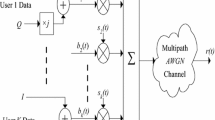Abstract
Due to near-far effects and multiple-access interference, several types of multiuser detectors have been developed in recent years to reliably demodulate user signals in a code-division multiple-access (CDMA) system. The downlink of Interim Standard 95 (IS-95) is particularly well suited to one such detector known as the successive interference canceler (SIC). In order to keep the receiver complexity low, entire base station signals are typically canceled in the receiver in a sequential manner. However, for the SIC to operate effectively, a base station signal that is being canceled must be reconstructed with enough accuracy such that sufficient interference power is removed for the subsequent base station to be reliably detected. If this is not possible, it may be necessary to employ techniques, specific to the signal format specified in the IS-95 downlink, which enhance the received signal-to-interference-plus-noise ratio (SINR). In this paper, we explore the performance gains achieved with several SINR enhancement techniques, and present computer simulations to demonstrate this improvement for example cochannel signal scenarios.
Similar content being viewed by others
References
Moshavi S., (Oct 1996). “Multi-user Detection for DS-CDMA Communications”. IEEE Commun. Mag. 34, 124–136
Honig M., Madhow U., Verdú S., (July 1995). “Blind Adaptive Multiuser Detection”. IEEE Trans. Inform. Theory 41, 944–960
Verdú S (Jan 1986). “Minimum Probability of Error for Asynchronous Gaussian Multiple-access Channels”. IEEE Trans. Inform. Theory 32:85–96
Madhow U, Honig M.L, (Dec 1994).“MMSE Interference Suppression for Direct-sequence Spread-spectrum CDMA”. IEEE Trans. Commun 42, 3178–3188
Duel-Hallen A., Holtzman J, Zvonar Z (April 1995) “Multiuser Detection for CDMA Systems”. IEEE Pers. Commun. 2, 46–58
Patel P, Holtzman J, (June 1994)“Analysis of a Simple Successive Interference Cancellation Scheme in a DS/CDMA System”. IEEE J. Sel. Areas Commun. 12, 796–807
Guo D, Rasmussen L.K, Sun S, Lim T.J,(Jan 2000) “A Matrix-Algebraic Approach to Linear Parallel Interference Cancellation in CDMA”. IEEE Trans. Commun. 48, 152–161
Rasmussen L.K, Lim T.J, Johansson A, (Jan 2000) “A Matrix-algebraicApproach to Successive Interference Cancellation in CDMA”. IEEE Trans. Commun. 48, 145–151
Varanasi M.K, Aazhang B (April 1990). “Multistage Detection in Asynchrnous Code-division Multiple-access Communications”. IEEE Trans. Commun. 38, 509–519
Telecommunications Industry Association, Mobile Station-Base Station Compatibility Standard for Wideband Spread Spectrum Cellular Systems. TIA/EIA-95-B, Washington, DC, Mar. 1999.
Goodman D.J, Wireless Personal Communications Systems, Reading, MA: Addison-Wesley, 1997.
Cagley R.E, and Shynk J.J, “Performance Evaluation of Power Control Bit Detection for an Adaptive SIC Receiver and the IS-95 Downlink”, in Proc. 35th Asilomar Conf. on Signals, Systems, and Computers, Pacific Grove, CA, pp. 629–633, Nov. 2001.
Frank C.D, and Visotsky E, “Adaptive Interference Suppression for Direct-sequence CDMA Systems with Long Spreading Codes”, in Proc. 36th Annual Allerton Conf. on Communication, Control, and Computing, Monticello, IL, pp. 411–420, Sept. 1998.
Lee J.S, Miller L.E (1998). CDMA Systems Engineering Handbook. Boston, Artech House
K.-C. Lai, Cagley R.E, Shynk J.J, Motamed M, and Gooch R.P, “Comparative Performance of Adaptive Receivers for Demodulating IS-95 Downlink Data”, in Proc. IEEE 2000 Adaptive Systems for Signal Processing, Communications, and Control Symp., Banff, Alberta, Canada, pp. 414–419, Oct. 2000.
Lai K.-C., Shynk J.J, (Oct 2001). “Steady-state Analysis of the Adaptive Successive Interference Canceler for DS/CDMA Signals”. IEEE Trans. Signal Processing 49, 2345–2362
Proakis J.G (1995). Digital Communications third ed. New York, McGraw-Hill
Liberti J.C, Jr. Rappaport T.S, (1999). Smart Antennas for Wireless Communications: IS-95 and Third Generation CDMA Applications. Upper Saddle River, NJ, Prentice-Hall
Cagley R.E, K.-Lai C, and Shynk J.J, “Performance of ML Rate Determination for an IS-95 Downlink SIC Receiver”, in Proc. 34th Asilomar Conf. on Signals, Systems, and Computers, Pacific Grove, CA, pp. 956–959, Oct. 2000.
Cagley R.E, Shynk J.J, and Gooch R.P, “SINR Enhancement in an IS-95 Downlink Receiver”, in Proc. IEEE Military Communications Conf., Anaheim, CA, pp. 790–793, Oct. 2002.
Garg V.K (2000). IS-95 CDMA and cdma2000: Cellular/PCS Systems Implementation. Upper Saddle River, NJ, Prentice-Hall
Holma H, Toskala A, eds., (2002). WCDMA for UMTS: Radio Access for Third Generation Mobile Communications. New York, Wiley
Author information
Authors and Affiliations
Corresponding author
Rights and permissions
About this article
Cite this article
Cagley, R.E., Shynk, J.J. & Gooch, R.P. SINR Enhancement Techniques for an IS-95 Downlink SIC Receiver. Wireless Pers Commun 41, 563–580 (2007). https://doi.org/10.1007/s11277-006-9161-3
Published:
Issue Date:
DOI: https://doi.org/10.1007/s11277-006-9161-3




